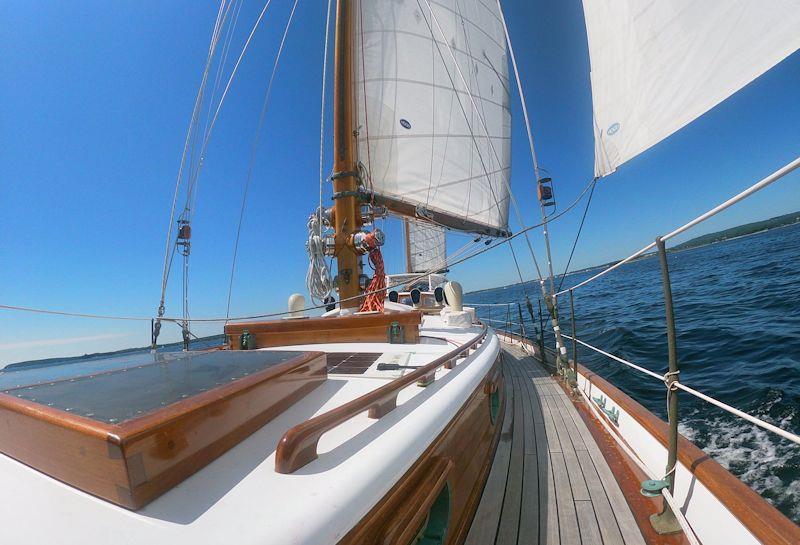
Andersen's Compact Electric Winches: Space-saving Saviour or Subpar Alternative?
by Phil Anniss 14 May 2021 01:00 PDT

Andersen Compact Electric Winch options for all applications © Andersen
When choosing an electric winch, motor placement is a critical design decision. In a previous article, we delved into the options, cross-examining the differences between a horizontal, vertical and compact motor placement.
The ultimate factor behind choosing the motor placement of your new electric winch is the configuration of your boat and the space available in the cabin headroom or storage locker. Compact electric winches take up the least amount of space and are perfect for boats where headroom is at a premium.
Harken and Andersen both offer a compact electric winch range, designed with a smaller motor that takes up less space below deck than a horizontal or vertical electric winch. In this article, we'll take a look at Andersen's compact range.
Andersen's Compact Electric Winch Range
Andersen offer two compact winch models: below deck or above deck. The latter requires no space below deck at all, with the motor mounted straight onto the deck.
A common question regarding compact electric winches is 'How does a compact winch compare? Does a smaller motor mean you are settling for less?'.
The short answer is no. In this case, smaller does not mean less power. To achieve this, Andersen's compact winches utilise a different motor technology than their horizontal configuration.
Andersen's compact winches use a 'brushless DC motor', more affectionately known as a 'pancake motor'. These motors have a lower, cylindrical profile, drastically reducing the space required.
And despite the smaller size, these motors pack a lot of punch! Let's take a look at Andersen's size 40 24V electric winch, for example.
| Horizontal | Compact - Below Deck | Compact - Above deck |
|---|
| Gear Ratio 1 (X:1) | 1.3 | 1.3 | 1.3 |
| Gear Ratio 2 (X:2) | 6 | 6 | 6 |
| Power Ratio 1 (X:1) | 8.9 | 8.9 | 8.9 |
| Power Ratio 2 (X:2) | 40 | 40 | 40 |
| Motor Length (mm) | 300 | 195 | 200 |
| Battery Capacity (ah) | 60 | 35 | 35 |
| Line Entry (mm) | 79 | 79 | 155 |
Advantages
As you can see from the table, all three models have the same power and gear ratios, but the compact models benefit from a dramatic battery saving. Whilst the horizontal model requires an additional 60 amp-hours of battery capacity per winch, the compact models require only 35 amp-hours per winch. This is far less draw on your boats electrical supply.
Another distinct advantage of Andersen's compact electric winches is the variable speed switch. When operating in their electric mode, most horizontal winches in the Andersen range typically operate at one speed, where there is no control on the speed of the winch.
This can have its drawbacks. For example, if the winch operator wanted to trim the sail, only needing a very small amount of line to be hauled in, having one electric speed can make it difficult, with the winch operating at a fast speed straight away as soon as the button is pressed. To get round this, the operator will have to only quickly press the button.
Andersen's compact winches have a variable speed switch, with the speed of winching changing depending on the pressure applied to the switch. Using this, the winch operator can lightly press the button and the winch will move slowly, until the desired sail shape has been achieved.
Drawbacks
However, there are some crucial things to bear in mind when considering a compact model. As Andersen's above deck model requires the motor to be mounted on deck, the line entry height is considerably higher, significantly altering the angle of approach of your lines. Your clutches, turning blocks and lines will likely need to be adjusted accordingly to achieve the recommended line entry angle of 3-8 degrees.
In addition, with the motor more exposed to the elements, additional precautions should be taken to protect from water ingress.
Price is also a major factor to consider: Andersen's compact electric winches are up to 60% more expensive than the horizontal configuration.
Conclusion
Andersen's compact electric winches are certainly a good choice for sailboats low on headroom space, and sailors can be certain they are not settling for less with regards to power. For sailboats where space is not a hindering factor, choosing Andersen's horizontal winch versus the compact range is a toss up between saving money or saving amp hours.
You can View the range of Andersen Winches on upffront.com or if you have any questions about switching to electric winches, you can contact or use the Winch Enquiry Form.